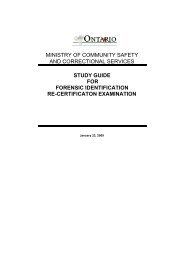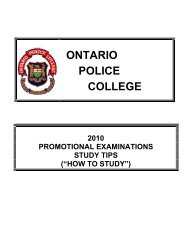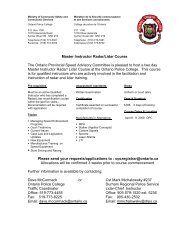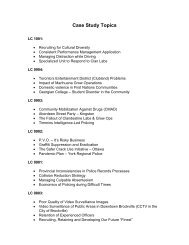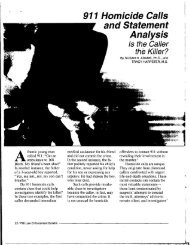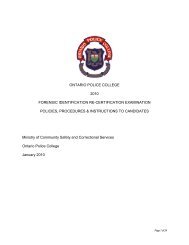General Study Guide - Ontario Police College
General Study Guide - Ontario Police College
General Study Guide - Ontario Police College
Create successful ePaper yourself
Turn your PDF publications into a flip-book with our unique Google optimized e-Paper software.
Developing Latent Prints on Tape – adhesive side.<br />
All processes are post visual and examination of inherent fluorescence by laser and alternate light source. Selection of development<br />
process is primarily dependent upon an attempt to produce the greatest contrast between the surface and the print.<br />
Latent Print<br />
Development Techniques and ‘Basics’ of Processing Procedure Development Colour<br />
Ridge Detail Visualized By<br />
Crystal / Gentian Violet<br />
Immerse tape in (adhesive side down) working solution for about<br />
10 seconds.<br />
If impression is weak, repeat the treatment<br />
Rinse tape in a dish of cool water or under a running tap for<br />
about 10 seconds<br />
Allow tape to dry; photograph<br />
Sticky-side Powder (Formulated in 1991 in Japan)<br />
can be applied as a thin paste with a brush or as a shallow bath<br />
in which the tape is immersed, sticky side uppermost.<br />
Purple<br />
Black<br />
Protein dye that stains epithelial skin cells, sebaceous<br />
lipids and proteins.<br />
Use F.L.S. at 525,530 & 570 nm & red goggles OR<br />
FLS at 485 or 450 nm and orange goggles.<br />
Photography then place tape, adhesive side down, on a<br />
sheet of clear acetate for protection<br />
See OPC notes for transfer of prints from dark tape (i.e.<br />
very little contrast between impression and substrate.<br />
Visible chemical reaction with sebaceous & lipid<br />
components + laser or alternate light source. (Also<br />
suggested that it is actually a physical process – SSP fill in<br />
the contours of the moulded impression left on the tape.)<br />
Liqui-Nox (Alternate Black Powder)<br />
Developed by Robin Bratton & Jeff Gregus of Michigan State<br />
<strong>Police</strong><br />
Black powder + Liqui-nox detergent<br />
Works similar to Sticky-Side Powder<br />
Solution is ‘painted’ onto the adhesive side with a camel hair<br />
brush then rinsed under a slow stream of running water.<br />
Ash Gray Powder<br />
Bonnie Martin of Oregon State <strong>Police</strong> modified the Sticky-Side<br />
Powder formula using white or ash gray powder in place of S.S.<br />
powder for better results against a black substrate.<br />
Black<br />
White to gray<br />
It is a relatively slow process & the resulting impressions<br />
may be faint. This process works best on light-coloured<br />
tape.<br />
Visible chemical reaction with sebaceous & eccrine<br />
components of fingerprint residue + laser or alternate<br />
light source.<br />
“In comparison testing with both the Sticky-side powder<br />
and Crystal Violet methods the black powder/Liqui-Nox<br />
method was found to be superior. Note – Liqui-Nox is a<br />
product of Fischer Scientific. It is a specially prepared<br />
detergent for laboratory use having no additives that may<br />
leave residues on glassware that could affect chemical<br />
processes.” (OPC Training Manual)<br />
Visible chemical reaction + Laser or alternate light source.



